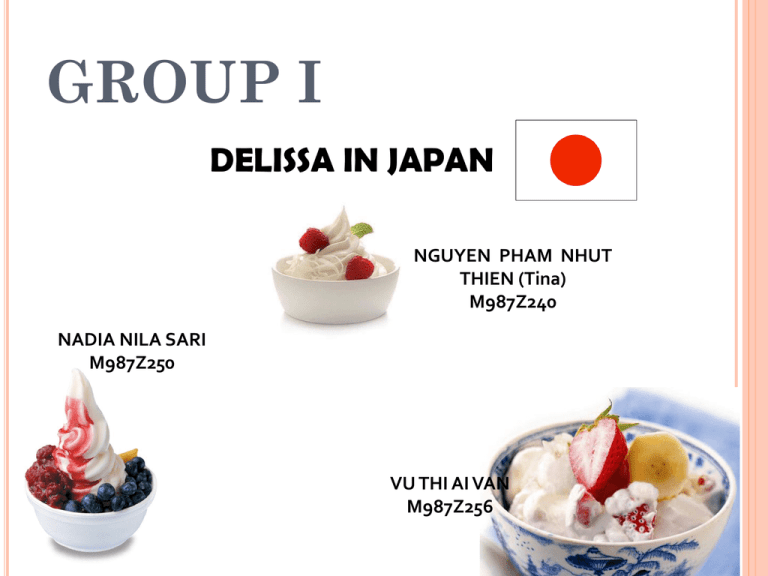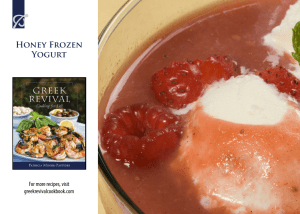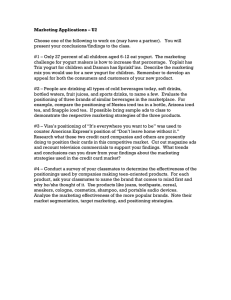GROUP I DELISSA IN JAPAN NGUYEN PHAM NHUT THIEN (Tina)
advertisement

GROUP I DELISSA IN JAPAN NGUYEN PHAM NHUT THIEN (Tina) M987Z240 NADIA NILA SARI M987Z250 VU THI AI VAN M987Z256 COMPANY Agria was founded in 1973 when a group of Swedish airy cooperatives decided to create a united organization that would develop and sell a line of fresh dairy products. Delissa line was launched in 1980. This was one of the few “national” lines of dairy products in Sweden. Including Yogurts, desserts, fresh cheese and fresh cream. By 2001 , more than 1.1 billion Delissa yogurts and desserts were being consumed per year worldwide. In fiscal year 2000, Delissa had sales of $2.9 billion and employed 4,400 people in and outside Sweden. Danone is the biggest competitor in worldwide. DELISSA OBJECTIVES IN JAPAN • • • • • • The total yogurt market in Japan for 1986 is approximately 600 million cups. Next five years’ expected market grow is at least 8%. Company’s launch strategy would be based on expected growth rate of 10% or 15% for the total market. First year, target of market share is 5% and 10% share of market within three years of launch. Company’s plan to cover the three main metropolitan areas, Tokyo, Osaka, and Nagoya, within two years period and the rest of the country within the next three years. Delissa’s share of the total yogurt market had fallen to 2% in 2001. CONSUMPTION IN JAPAN • • • • Per capita consumption of yogurt in Japan is estimated at around 5.3 cups per person per year in Japan, versus 110 in Sweden and 120 in Finland. Seasonal sale is in Japan through March to July. The highest sales have been recorded in June so ideal launch date would be at the end of February. 80 % of yogurt is sold through supermarkets. TYPES OF YOGURT IN JAPAN Plain yogurt 39 % of the market in volume Flavored yogurt 45 % of the market in volume Fruit yogurt 16 % of the market in volume COMPETITION Company Products Turnover in 1989 Snow Brand Milk Products Drinking milk, Cheese Frozen foods, biochemicals Pharmaceuticals 643,322 million Yen Meiji Milk Products Dried milk for babies, Ice cream, cheese 610,674 million Yen Morinaga Milk Industry Drinking milk, ice cream, Instant coffee 561,783 million Yen The Japanese also consume a yogurt drink called ‘’ which is often included in statistics on total yogurt consumption as it competes with normal yogurt. 4P’S BEFORE 1994 Products Plain (packs of 2 and 4) Plain with sugar (packs of 2 and 4) Flavored with vanilla, strawberry an pineapple All three types were to be sold in 120 ml cups Promotion Television, newspaper, magazine, Street shows In-store promotions, Test trials Outside retail stores Price Following the top brands in Japan to respect a high-class image Should be affordable for the house-wife Delissa could be priced at 15% above competitive products. Place Cover the three main metropolitan areas: Tokyo, Osaka, Nagoya ENTRY STRATEGY ” new milk-related products” SRT International advertising Agency help Delissa entry new market The concept “natural dairy food is good to taste”helped Agria saturate the market with Delissa brand and compete with its competitors. Nikko made distinguish its products from those of earlyentry dairy” new and natural and quite different from any other yogurts” The core target group has been defined as families with babies. However, the products are consumed by a wider age bracket from young children to high school students. The concept “ freshness” will capture the consumers’ interest as well as clearly differentiate Delissa from other brands and the message “ healthy products direct from the farm and sophisticated taste from Sweden” attract housewives in Japan. Japanese housewives were becoming more diet conscious so it might be advisable to mention the dietary value of Delissa To reinforce the product’s image and increase brand awareness SRT always use specific visual and verbal messages be used throughout the promotional campaign “refreshing nature of Delissa Swedish yogurt; it is so fresh when it’s made at the farm” THE FRANCHISE CONTRACT In late 1989 Nikko and Agria had signed an industrial franchise agreement permitting Nikko to manufacture and distribute Delissa products under license from Agria. Agria was to provide manufacturing and product knowhow, as well as marketing, technical, commercial and sale support. Agria would receive a royalty for every pot of yogurt sold. In 1990 Agria provided Nikko with advice on technology, machinery, tanks, fermentation process, etc. Nikko cooperative would form a separate company for the distribution, marketing and promotion of Delissa products. JOINT VENTURE COMPETITORS The company signed an agreement with a Japanese partner, Ajinomoto. Their joint venture , Ajinomoto-Danone Co.ltd, is run by a French expatriate together with several Japanese directors. Ajinomoto has a very successful joint venture with General foods for “ Maxwell House” the instant coffee. However, Ajinomoto had had no experience at all in dealing with fresh products before entering the joint venture with Danone 1994 : DELISSA AFTER THREE YEARS IN JAPAN Three years after launch, Delissa – with 2 % of Japanese yogurt market. Product slow progrees in Japan. DISTRIBUTION / ORDERING SYSTEM DAY ORDERING SYSTEM Day 1 a.m Each salesman sent an order to his depot Day 1 pm Each depot order went ti the Yokohama depot Day 2 a.m The Yokohama depot transmits the order to the factory Day 2 p.m Yogurt was produced at Nikko Milk Processing Day 3 Delivery to each depot Day 4 Delivery to stores •Delivery process is to long for fresh product. PROMOTION Advertising not too successful, advertising message are not too cluttered. Result cutomer research survey showed : 4% unaided awareness 16% had any recall at all 55 % respondent didn’t know what the TV commercial were trying to say. Survey said that advertising effectiveness indicated that we should stress the fact that Delissa tastes good ( delicious ). SITUATION LEADING UP TO 2001 Had less than 3 % in total market 2001 , the result has been far below expectation Discover limited distribution network outside major metropolitan area ( small cities, town and rural area ) Japanese market brand loyalty is low Lack of marketing, distribution is one of the most problem. PRODUCT In 2001 plain yogurt 43 % in the total Japanese market. And grown 50% in this past 3 years. 1998 fruit yogurt segment growth 25%, should be 23% next year. Yogurt with jelly : 1.2 million cup 3 month after introduction. Custard and chocolate pudding sales disappointed. Plain yogurt is very good. Mid Year result : 55 million 120 ml ( 2002 ) Present date only 42 million. Stores covered In Nikko’s store Delissa sell about 71 %. 7000 store cover in Great Tokyo. Product Return April 2000 to March 2001 : 5.06% vs almost 0% in Scandinavia and the international standart of 2% to 3%. The average shelf life in yogurt in Japan is 14 days. MEDIA PLANNING Delissa target is : Young people between 13 -24 y.o Children Nikko and agency running TV spots for young people and children – from 11.15 to 12.15 at night. With this late night spot Nikko try to reach customer and distributor. Target group is children but they spot in late night. The price of 15 second spot in Tokyo are between Yen 1.25 million and Yen 2.3 million in 2000. Largest segment in Japan : 1. Plain yogurt 2. Flavored 3. Fruit Brand Awareness : Unaided Brand awareness : 1.Meiji Bulgaria 2. Morinaga Bifidus 3. Yoplait 4. Danone 5. Delissa People Focus on house-wives in Japan Package Packs of 2 and 4 for Plain Yogurt Packs of 2 and 4 for Plain with sugar Packs of 2 for Flavored with vanilla, strawberry and pineapple Advertising Awareness Top ranking : 1. Bifidus 43% 2. Bulgaria 41% 3. Delissa 36% 4. Danone 28% 5. Yoplait 26% Advertising for Delissa : 1. TV 94 % 2. In-store promotion 6 % 3. Newspaper 4 % 4. Magazine 4 % 65% Delissa ads recall something about the content and current ads 9 % recalled previous adv. 55 % did know what the advertising trying to say. CONSUMPTION In fruit segment : • • • • Yoplait ( 10 % ) Bulgaria ( 8 % ) Delissa ( 5 % ) Dannone ( 4% ) Brand mainly consumed by respondent: 1. Bulgaria 2. Bifidus 3. Delissa 1. 2. 3. 4. 5. Respondent had consumed plain yogurt ( past month ) : 28 % Bulgaria 15 % Bifidus 5 % Yoplait 4 % Danone 3 % Delissa The number who ever tried : • Delissa 22% • Bulgaria 66 % ANALYSIS & SUGGESTION The Francisee Contract : Cultural gap problem Communication Product Distribution Advertising WHAT AGRIA SHOULD DO ? Cancle contract & find another distribution ? Renew the arrangement with Nikko and continue to try to gain market share ? Admit defeat and withdraw from Japan completely ? Since : Market large and high potential Delissa taste in not bad as other competitor Delissa’s Yogurt with jelly : 1.2 million cup 3 month after introduction. Our group choose to renew contract and try to gain market in Japan. But first have to do is fix patnership problem between Agria and Nikko for Delissa product and then fix problem in product, distribution and advertising. THE FRANCHISE CONTRACT : Before Agria renew contract with Nikko, they should Doing evaluation on their patnership. The cultural gap between two company may happen because of lack knowlegde in both Different culture between Swedian and Japanese. In this case if that’s happen the two company should understand the cross culture Patnership, such us different national culture and organization culture and building trust by communication, corperation, commitment and conflict resolution. But if the problem could not resolve, both company can use mediator ways. The Franchisors and franchisees should first attempt to resolve the issue before referring to an external agency ( mediator ). A normal dispute resolution procedure will at first attempt resolution informally, then by a formal written notice which will generally include the nature of the dispute, and desired outcome to resolve the dispute, and a timeframe for this to occur. For example In Australia, under the Franchising Code of Conduct, serious disputes that cannot be resolved between the franchise parties themselves, should be referred to mediation. PRODUCT Market in Volume Plain 16% Flavored Fruit 39% 45% Customer like most Jelly Yogurt Flavour, it means Delissa could create more innovating Jelly Yogurt . Also focus production : 1. priority on flavoured yogurt, 2. in plain yogurt and 3. priority in fruit yogurt. Delissa has strong fasionable image, and this can be used in their packaging provide fashionable design to strenghtened the image. TARGET MARKET : Families with babies. Young housewives as principal purchaser. Young people between 13 -24 years old Children DISTRIBUTOR Try Yakult strategy in Direct selling ( door to door sales ) to employee. By giving discount in first or second month subscriber. Mass sales retailer distribution to : Supermarket / convenience store Retailer / wholeseller Smaller local store Fix the transportation to distribute: The refrigated milk van with fairly small (less than 2 tons ) to drive down the narrow space. DISTRIBUTION CHANNEL Cut distribution channel : BEFORE : ( 6 channel ) Salesman – Depot - Yokohama depot – Factory ( produce at Nikko Milk Processing ) – Depot – Stores - Delivery process is to long for fresh product. - The time should be shortened to only one day. TO : ( 3 channel ) Salesman – factory – store ( to keep the freshness ) - Since the smaller outlets have very little storage space, wholesalers often have to visit them more than once a day. ADVERTISING Unaided awareness and brand awareness of Delissa is so low better than the other competitor. 4. Advertising for Delissa : TV 94 % In-store promotion 6 % Newspaper 4 % Magazine 4 % 55 % did know what the advertising trying to say. 1. 2. 3. Fix the television advertising with clear message and bring to the customer about brand image and positioning of Delissa : “ Fresh, fashionable and delicious yogurt “. Focus on television advertising around peak period on March to July. TV ads in Sunday morning or in school holiday, during cartoon movie to target children. And during teenagers series for the youth. With endorsement that represent kids and youth. Free tester of Delissa yogurt for in-store promotion Delissa and put Delissa near the cashier rack to attract customer and establish awareness for the brand. CONCLUSION We learn from the case that problem patnership ( franchise or joint venture ) could be happen, in cross culture problem or anything else. Both company ( Agria and Nikko ) should understand the culture of other company ( wheather is nation culture or organization culture ). If the problem couldn’t be solve easily they can use mediator or even defeat and withdraw from the company and market. Japan market is potential, so Delissa have big chance to growth in Japan market, with specific and unique positioning, good advertising and fast also effective distribution, Delissa will success in Japan market.


